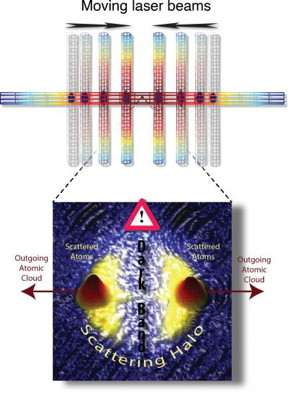Home > Press > Physicists collide ultracold atoms to observe key quantum principle
 |
| University of Otago physicist Niels Kjærgaard and his team have used extremely precisely controlled laser beams to confine, accelerate and gently collide ultracold atomic clouds of fermionic potassium.
This allowed them to directly observe a key principle of quantum theory, the Pauli Exclusion Principle. This principle predicts a forbidden zone along a meridian of the spherical halo of scattered particles, which the Otago experiments indeed unveiled. The dark band in the graphic shows a rule derived from the principle in action. This rule is that indistinguishable fermions cannot scatter out at 90 degrees to the collision axis. CREDIT: Niels Kjærgaard |
Abstract:
Physicists from New Zealand's University of Otago have used steerable 'optical tweezers' to split minute clouds of ultracold atoms and slowly smash them together to directly observe a key theoretical principle of quantum mechanics.
Physicists collide ultracold atoms to observe key quantum principle
Dunedin, New Zealand | Posted on July 13th, 2016The principle, known as Pauli Exclusion, places fundamental constraints on the behavior of groups of identical particles and underpins the structure and stability of atoms as well as the mechanical, electrical, magnetic and chemical properties of almost all materials.
Otago Physics researcher Associate Professor Niels Kjærgaard led the research, which is newly published in the prestigious journal Nature Communications.
Kjærgaard and his team used extremely precisely controlled laser beams to confine, accelerate and gently collide ultracold atomic clouds of fermionic potassium. The atomic clouds had a temperature of a mere millionth of degree Kelvin above absolute zero.
The Pauli Exclusion Principle predicts a forbidden zone along a meridian of the spherical halo of scattered particles, which the experiments indeed unveiled.
"This dark band results from a 'no side-stepping' rule that the principle dictates, which is that indistinguishable fermions cannot scatter out at 90 degrees to the collision axis," Kjærgaard says.
When PhD student Ryan Thomas looked more closely at his data, he found that under some conditions the images of scattering halos from the particles would actually display side-stepping--the dark band would be less dark.
"This is not because the rule suddenly breaks down, but because there can be situations where a particle scatters multiple times with consecutively new collision axes," Associate Professor Kjærgaard says.
This particular finding has important implications for gaining insights into the particulars of the underlying processes governing multiple particle scattering.
###
The work was supported by the Marsden Fund of New Zealand.
####
For more information, please click here
Contacts:
Niels Kjærgaard
Copyright © University of Otago
If you have a comment, please Contact us.Issuers of news releases, not 7th Wave, Inc. or Nanotechnology Now, are solely responsible for the accuracy of the content.
| Related Links |
| Related News Press |
Quantum Physics
![]() Simulating magnetization in a Heisenberg quantum spin chain April 5th, 2024
Simulating magnetization in a Heisenberg quantum spin chain April 5th, 2024
![]() Discovery points path to flash-like memory for storing qubits: Rice find could hasten development of nonvolatile quantum memory April 5th, 2024
Discovery points path to flash-like memory for storing qubits: Rice find could hasten development of nonvolatile quantum memory April 5th, 2024
News and information
![]() Simulating magnetization in a Heisenberg quantum spin chain April 5th, 2024
Simulating magnetization in a Heisenberg quantum spin chain April 5th, 2024
![]() NRL charters Navy’s quantum inertial navigation path to reduce drift April 5th, 2024
NRL charters Navy’s quantum inertial navigation path to reduce drift April 5th, 2024
Discoveries
![]() Chemical reactions can scramble quantum information as well as black holes April 5th, 2024
Chemical reactions can scramble quantum information as well as black holes April 5th, 2024
![]() New micromaterial releases nanoparticles that selectively destroy cancer cells April 5th, 2024
New micromaterial releases nanoparticles that selectively destroy cancer cells April 5th, 2024
![]() Utilizing palladium for addressing contact issues of buried oxide thin film transistors April 5th, 2024
Utilizing palladium for addressing contact issues of buried oxide thin film transistors April 5th, 2024
Announcements
![]() NRL charters Navy’s quantum inertial navigation path to reduce drift April 5th, 2024
NRL charters Navy’s quantum inertial navigation path to reduce drift April 5th, 2024
![]() Discovery points path to flash-like memory for storing qubits: Rice find could hasten development of nonvolatile quantum memory April 5th, 2024
Discovery points path to flash-like memory for storing qubits: Rice find could hasten development of nonvolatile quantum memory April 5th, 2024
Interviews/Book Reviews/Essays/Reports/Podcasts/Journals/White papers/Posters
![]() Simulating magnetization in a Heisenberg quantum spin chain April 5th, 2024
Simulating magnetization in a Heisenberg quantum spin chain April 5th, 2024
![]() Discovery points path to flash-like memory for storing qubits: Rice find could hasten development of nonvolatile quantum memory April 5th, 2024
Discovery points path to flash-like memory for storing qubits: Rice find could hasten development of nonvolatile quantum memory April 5th, 2024
|
|
||
|
|
||
| The latest news from around the world, FREE | ||
|
|
||
|
|
||
| Premium Products | ||
|
|
||
|
Only the news you want to read!
Learn More |
||
|
|
||
|
Full-service, expert consulting
Learn More |
||
|
|
||








